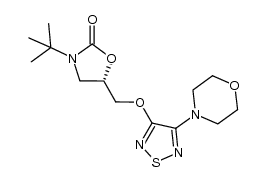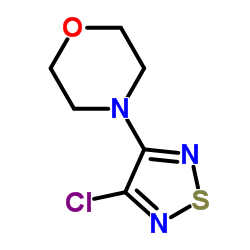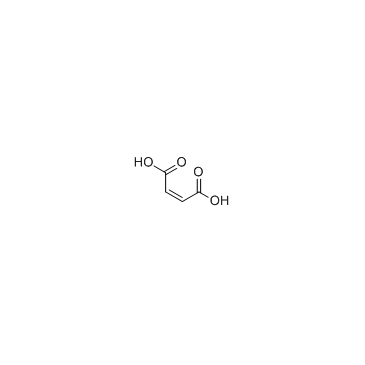(S)-timolol maleate

(S)-timolol maleate structure
|
Common Name | (S)-timolol maleate | ||
|---|---|---|---|---|
| CAS Number | 26921-17-5 | Molecular Weight | 432.492 | |
| Density | N/A | Boiling Point | 704.6ºC at 760 mmHg | |
| Molecular Formula | C17H28N4O7S | Melting Point | 202-203 °C(lit.) | |
| MSDS | Chinese USA | Flash Point | 380ºC | |
| Symbol |


GHS07, GHS08 |
Signal Word | Warning | |
Use of (S)-timolol maleate(S)-Timolol maleate, is a potent non-selective β-adrenergic receptor antagonist (Ki values are 1.97 and 2.0 nM for β1 and β2 receptor subtypes respectively). IC50 Value: 1.97 nM(Ki for β1); 2.0 nM(Ki for β2)Target: β-adrenergic receptor(S)-Timolol, 50% bioavailability following oral administration. Does not cross the blood brain barrier. Timolol maleate does appear to have some local anesthetic properties in human cornea after chronic use by susceptible individuals. |
| Name | (S)-timolol maleate |
|---|---|
| Synonym | More Synonyms |
| Description | (S)-Timolol maleate, is a potent non-selective β-adrenergic receptor antagonist (Ki values are 1.97 and 2.0 nM for β1 and β2 receptor subtypes respectively). IC50 Value: 1.97 nM(Ki for β1); 2.0 nM(Ki for β2)Target: β-adrenergic receptor(S)-Timolol, 50% bioavailability following oral administration. Does not cross the blood brain barrier. Timolol maleate does appear to have some local anesthetic properties in human cornea after chronic use by susceptible individuals. |
|---|---|
| Related Catalog | |
| References |
| Boiling Point | 704.6ºC at 760 mmHg |
|---|---|
| Melting Point | 202-203 °C(lit.) |
| Molecular Formula | C17H28N4O7S |
| Molecular Weight | 432.492 |
| Flash Point | 380ºC |
| Exact Mass | 432.167877 |
| PSA | 182.58000 |
| LogP | 0.67020 |
| Appearance of Characters | powder | white to off-white |
| Vapour Pressure | 7.7E-21mmHg at 25°C |
| Storage condition | Store at RT |
| Water Solubility | H2O: soluble |
|
Section 1. Chemical Product and Company Identification Timolol Maleate Common Name/ Trade Name Timolol Maleate Section 4. First Aid Measures Eye ContactCheck for and remove any contact lenses. In case of contact, immediately flush eyes with plenty of water for at
least 15 minutes. Cold water may be used. Get medical attention if irritation occurs. Skin ContactWash with soap and water. Cover the irritated skin with an emollient. Get medical attention if irritation develops. Cold water may be used. Serious Skin ContactNot available. InhalationIf inhaled, remove to fresh air. If not breathing, give artificial respiration. If breathing is difficult, give oxygen. Get medical attention. Serious InhalationNot available. IngestionDo NOT induce vomiting unless directed to do so by medical personnel. Never give anything by mouth to an unconscious person. If large quantities of this material are swallowed, call a physician immediately. Loosen tight clothing such as a collar, tie, belt or waistband. Serious IngestionNot available. Section 5. Fire and Explosion Data Flammability of the Product May be combustible at high temperature. Auto-Ignition Temperature Not available. Flash PointsNot available. Flammable LimitsNot available. These products are carbon oxides (CO, CO2), nitrogen oxides (NO, NO2...), sulfur oxides (SO2, SO3...). Products of Combustion Fire Hazards in Presence of Slightly flammable to flammable in presence of heat. Various SubstancesNon-flammable in presence of shocks. Explosion Hazards in Presence Slightly explosive in presence of open flames and sparks. of Various SubstancesNon-explosive in presence of shocks. Fire Fighting MediaSMALL FIRE: Use DRY chemical powder. and InstructionsLARGE FIRE: Use water spray, fog or foam. Do not use water jet. Special Remarks onAs with most organic solids, fire is possible at elevated temperatures Fire Hazards Special Remarks on Explosion Fine dust dispersed in air in sufficient concentrations, and in the presence of an ignition source is a potential dust Hazardsexplosion hazard. Section 6. Accidental Release Measures Small SpillUse appropriate tools to put the spilled solid in a convenient waste disposal container. Finish cleaning by spreading water on the contaminated surface and dispose of according to local and regional authority requirements. Large Spill Use a shovel to put the material into a convenient waste disposal container. Finish cleaning by spreading water on the contaminated surface and allow to evacuate through the sanitary system. Timolol Maleate Section 7. Handling and Storage PrecautionsKeep away from heat. Keep away from sources of ignition. Ground all equipment containing material. Do not ingest. Do not breathe dust. Wear suitable protective clothing. If ingested, seek medical advice immediately and show the container or the label. StorageKeep container tightly closed. Keep container in a cool, well-ventilated area. Sensitive to light. Section 8. Exposure Controls/Personal Protection Engineering ControlsUse process enclosures, local exhaust ventilation, or other engineering controls to keep airborne levels below recommended exposure limits. If user operations generate dust, fume or mist, use ventilation to keep exposure to airborne contaminants below the exposure limit. Personal ProtectionSafety glasses. Lab coat. Dust respirator. Be sure to use an approved/certified respirator or equivalent. Gloves. Personal Protection in Case of Splash goggles. Full suit. Dust respirator. Boots. Gloves. A self contained breathing apparatus should be used a Large Spillto avoid inhalation of the product. Suggested protective clothing might not be sufficient; consult a specialist BEFORE handling this product. Exposure LimitsNot available. Section 9. Physical and Chemical Properties Physical state and appearance Solid. (Crystalline powder. Crystals solid.)OdorOdorless. TasteNot available. Molecular Weight432.49 g/mole ColorWhite. Off-white. pH (1% soln/water)Not available. Not available. Boiling Point Melting PointDecomposition temperature: 199°C (390.2°F) Not available. Critical Temperature Specific GravityNot available. Vapor PressureNot applicable. Vapor DensityNot available. VolatilityNot available. Odor ThresholdNot available. Water/Oil Dist. Coeff.Not available. Ionicity (in Water)Not available. Dispersion PropertiesSee solubility in water. SolubilitySoluble in cold water. Insoluble in diethyl ether. Sparingly soluble in chloroform. Soluble in ethanol. Section 10. Stability and Reactivity Data StabilityThe product is stable. Instability TemperatureNot available. Conditions of InstabilityExcess heat, dust generation, light Incompatibility with various Not available. substances Timolol Maleate Not available. Corrosivity Special Remarks onSensitive to light. Reactivity Special Remarks onNot available. Corrosivity Will not occur. Polymerization Section 11. Toxicological Information Routes of EntryInhalation. Ingestion. Toxicity to AnimalsAcute oral toxicity (LD50): 1028 mg/kg [Rat]. Chronic Effects on Humans Not available. Other Toxic Effects onSlightly hazardous in case of skin contact (irritant), of ingestion, of inhalation. Humans Special Remarks onNot available. Toxicity to Animals Special Remarks onNot available. Chronic Effects on Humans Special Remarks on otherAcute Potential Health Effects: Toxic Effects on HumansSkin: May cause skin irritation. Eyes: May cause eye irritation. Inhalation: May cause respiratory tract and mucous membrane irritation. Ingestion: May be harmful if swallowed. May cause nausea, vomiting, diarrhea, fatigue, bradycardia, congestive heart failure, heart block, hypertension, cold extremities, depression, convulsions, tremor, somnolence, and disturbances of sleep and vision. May also affect respiration (dyspnea), urinary system, liver, and spleen. Section 12. Ecological Information EcotoxicityNot available. BOD5 and CODNot available. Products of BiodegradationPossibly hazardous short term degradation products are not likely. However, long term degradation products may arise. Toxicity of the ProductsThe products of degradation are less toxic than the product itself. of Biodegradation Not available. Special Remarks on the Products of Biodegradation Section 13. Disposal Considerations Waste DisposalWaste must be disposed of in accordance with federal, state and local environmental control regulations. Timolol Maleate Section 14. Transport Information DOT ClassificationNot a DOT controlled material (United States). IdentificationNot applicable. Not applicable. Special Provisions for Transport DOT (Pictograms) Section 15. Other Regulatory Information and Pictograms No products were found. Federal and State Regulations CaliforniaCalifornia prop. 65: This product contains the following ingredients for which the State of California has found to cause cancer which would require a warning under the statute: No products were found. Proposition 65 Warnings California prop. 65: This product contains the following ingredients for which the State of California has found to cause birth defects which would require a warning under the statute: No products were found. Other RegulationsEINECS: This product is on the European Inventory of Existing Commercial Chemical Substances. Other ClassificationsWHMIS (Canada) Not controlled under WHMIS (Canada). DSCL (EEC)R22- Harmful if swallowed.S2- Keep out of the reach of children. S46- If swallowed, seek medical advice immediately and show this container or label. Health Hazard HMIS (U.S.A.)1 National Fire Protection 1 Flammability 1 Association (U.S.A.) Fire Hazard 1 0 Reactivity Health Reactivity 0 Specific hazard Personal Protection E WHMIS (Canada) (Pictograms) DSCL (Europe) (Pictograms) TDG (Canada) (Pictograms) ADR (Europe) (Pictograms) Timolol Maleate Protective Equipment Gloves. Lab coat. Dust respirator. Be sure to use an approved/certified respirator or equivalent. SECTION 16 - ADDITIONAL INFORMATION N/A |
CHEMICAL IDENTIFICATION
HEALTH HAZARD DATAACUTE TOXICITY DATA
|
| Symbol |


GHS07, GHS08 |
|---|---|
| Signal Word | Warning |
| Hazard Statements | H302-H361 |
| Precautionary Statements | P280-P301 + P312 + P330 |
| Personal Protective Equipment | Eyeshields;full-face particle respirator type N100 (US);Gloves;respirator cartridge type N100 (US);type P1 (EN143) respirator filter;type P3 (EN 143) respirator cartridges |
| Hazard Codes | Xn,Xi |
| Risk Phrases | R22 |
| Safety Phrases | S36 |
| RIDADR | NONH for all modes of transport |
| WGK Germany | 3 |
| RTECS | UA8475000 |
| HS Code | 2934999090 |
| HS Code | 2934999090 |
|---|---|
| Summary | 2934999090. other heterocyclic compounds. VAT:17.0%. Tax rebate rate:13.0%. . MFN tariff:6.5%. General tariff:20.0% |
|
Different compartmentation of responses to brain natriuretic peptide and C-type natriuretic peptide in failing rat ventricle.
J. Pharmacol. Exp. Ther. 350(3) , 681-90, (2014) We previously found a negative inotropic (NIR) and positive lusitropic response (LR) to C-type natriuretic peptide (CNP) in the failing heart ventricle. In this study, we investigated and compared the... |
|
|
Dual drug delivery from vitamin E loaded contact lenses for glaucoma therapy.
Eur. J. Pharm. Biopharm. 94 , 312-21, (2015) Glaucoma patients frequently instill eye drops multiple times each day, which is a cause for reduced compliance. Additionally, eye drops suffer from other limitations including low bioavailability, wh... |
|
|
Author reply: To PMID 24576886.
Ophthalmology 121(12) , e68, (2014)
|
| (-)-1-(tert-Butylamino)-3-[(4-morpholino-1,2,5-thiadiazol-3-yl)oxy]-2-propanol Maleate (1:1) (Salt) |
| (S)-1-[(1,1-Dimethylethyl)amino]-3-[[4-(4-morpholinyl)-1,2,5-thiadiazol-3-yl]oxy]-2-propanol (Z)-2-Butenedioate (1:1) (Salt) |
| Timolol maleate salt |
| Betim |
| acide (2Z)-but-2-ènedioïque - (2S)-1-[(1,1-diméthyléthyl)amino]-3-[(4-morpholin-4-yl-1,2,5-thiadiazol-3-yl)oxy]propan-2-ol (1:1) |
| Tenopt |
| (2Z)-But-2-endisäure--(2S)-1-(tert-butylamino)-3-[(4-morpholin-4-yl-1,2,5-thiadiazol-3-yl)oxy]propan-2-ol(1:1) |
| Proflax |
| Aquanil |
| (2S)-1-[(2-Methyl-2-propanyl)amino]-3-{[4-(4-morpholinyl)-1,2,5-thiadiazol-3-yl]oxy}-2-propanol (2Z)-2-butenedioate (1:1) |
| Timorom |
| (2S)-1-(tert-Butylamino)-3-{[4-(morpholin-4-yl)-1,2,5-thiadiazol-3-yl]oxy}propan-2-ol (2Z)-but-2-enedioate (1:1) |
| (S)-Timolol maleate |
| Rysmon TG |
| EINECS 248-111-5 |
| Optimol |
| (-)-Timolol Maleate |
| Timacar |
| (S)-(-)-Timolol Maleate |
| (2S)-1-(tert-butylamino)-3-[(4-morpholin-4-yl-1,2,5-thiadiazol-3-yl)oxy]propan-2-ol (2Z)-but-2-enedioate (salt) |
| (2S)-1-[(1,1-Dimethylethyl)amino]-3-[[4-(4-morpholinyl)-1,2,5-thiadiazol-3-yl]oxy]-2-propanol (2Z)-2-Butenedioate (1:1) (Salt) |
| Temserin |
| MFCD00058356 |
| 2-Propanol, 1-[(1,1-dimethylethyl)amino]-3-[[4-(4-morpholinyl)-1,2,5-thiadiazol-3-yl]oxy]-, (2S)-, (2Z)-2-butenedioate (1:1) (salt) |
| Timolol maleate |
| (S)-Timolol (Maleate) |
 CAS#:30165-97-0
CAS#:30165-97-0![rac 4-[4-(Oxiranylmethoxy)-1,2,5-thiadiazol-3-yl]morpholine Structure](https://image.chemsrc.com/caspic/270/58827-68-2.png) CAS#:58827-68-2
CAS#:58827-68-2 CAS#:56526-15-9
CAS#:56526-15-9 CAS#:30165-96-9
CAS#:30165-96-9![(S)-4-[4-(Oxiranylmethoxy)-1,2,5-thiadiazol-3-yl]morpholine Structure](https://image.chemsrc.com/caspic/376/69500-53-4.png) CAS#:69500-53-4
CAS#:69500-53-4 CAS#:85665-60-7
CAS#:85665-60-7 CAS#:26839-75-8
CAS#:26839-75-8 CAS#:110-16-7
CAS#:110-16-7